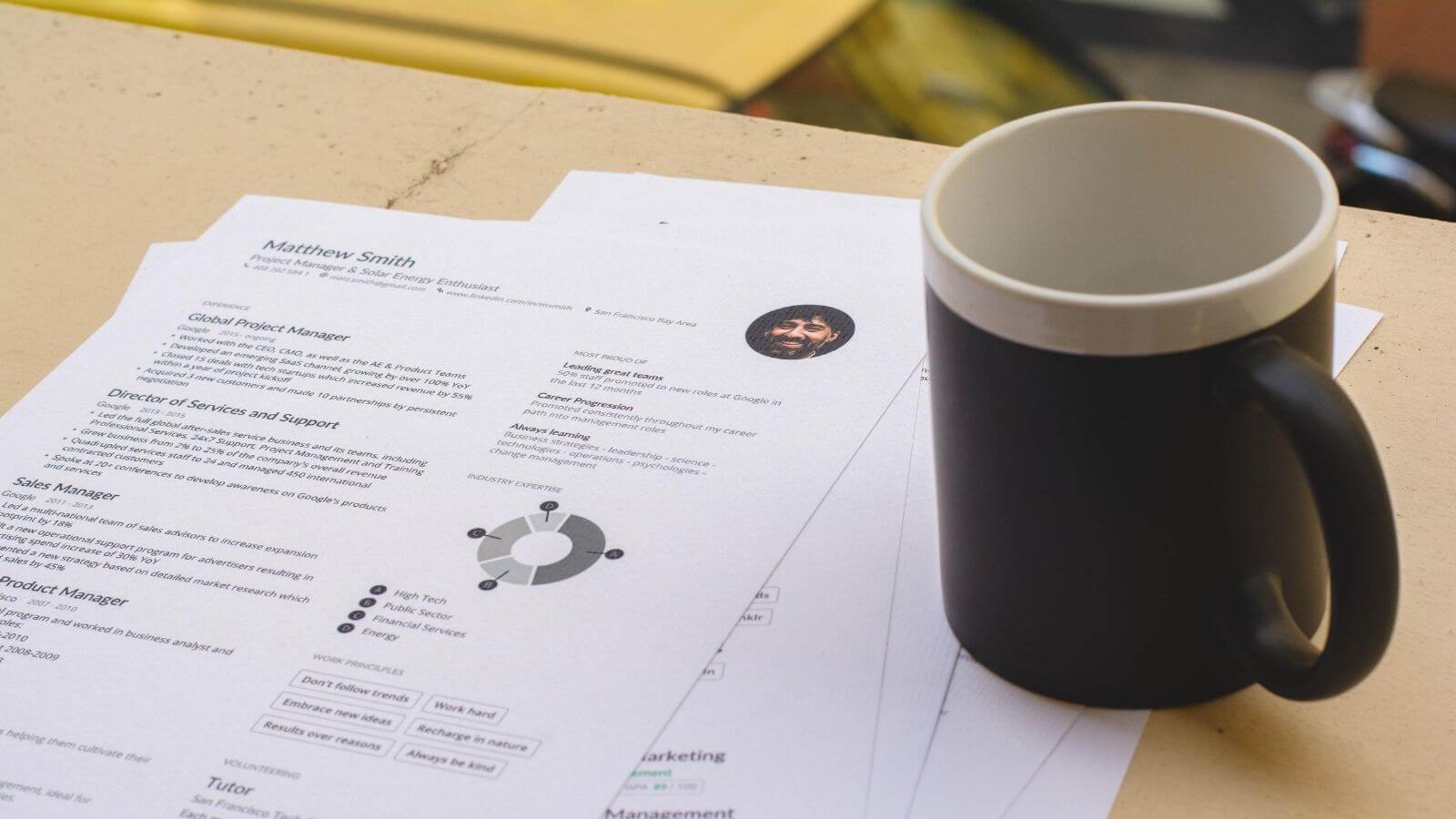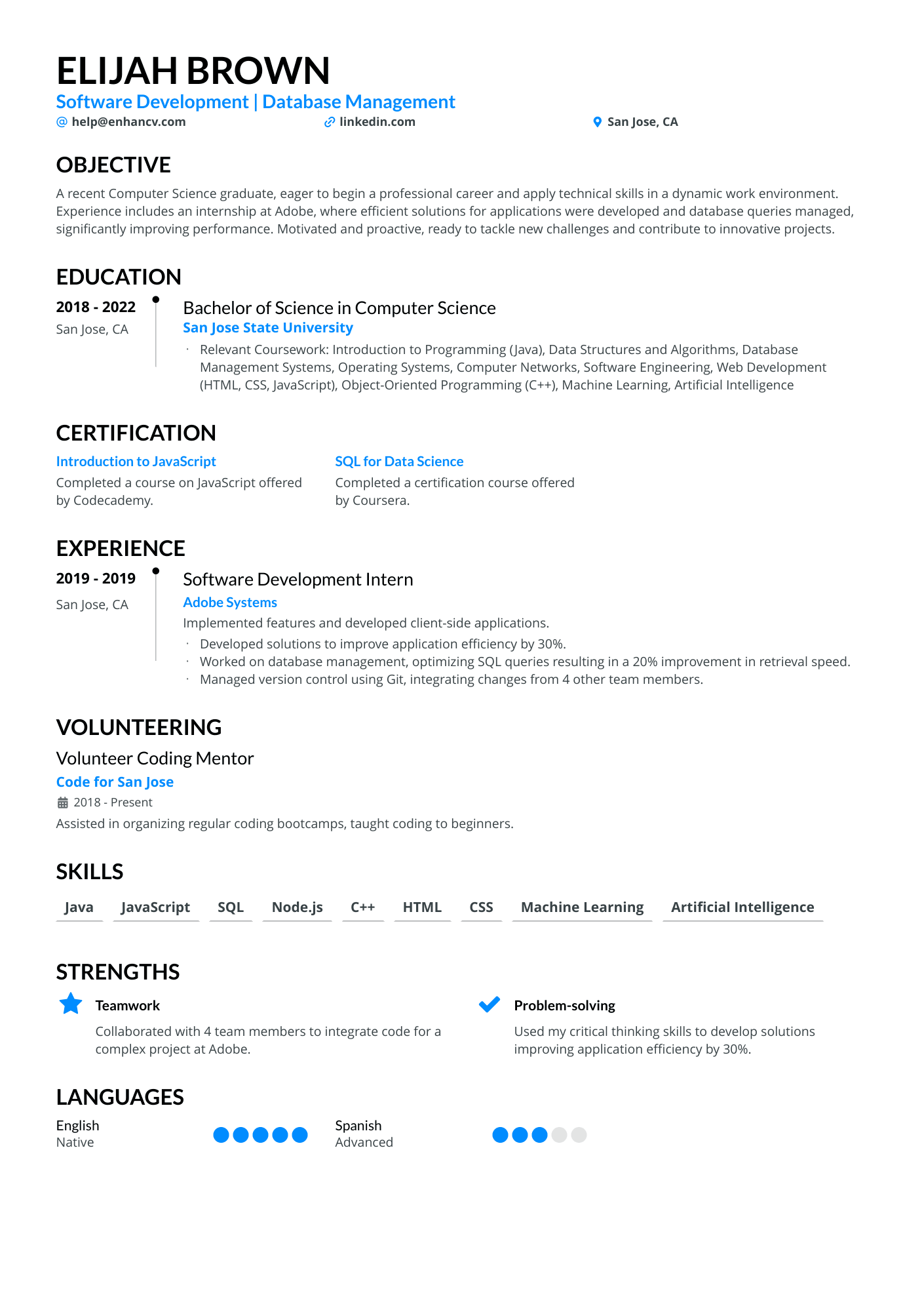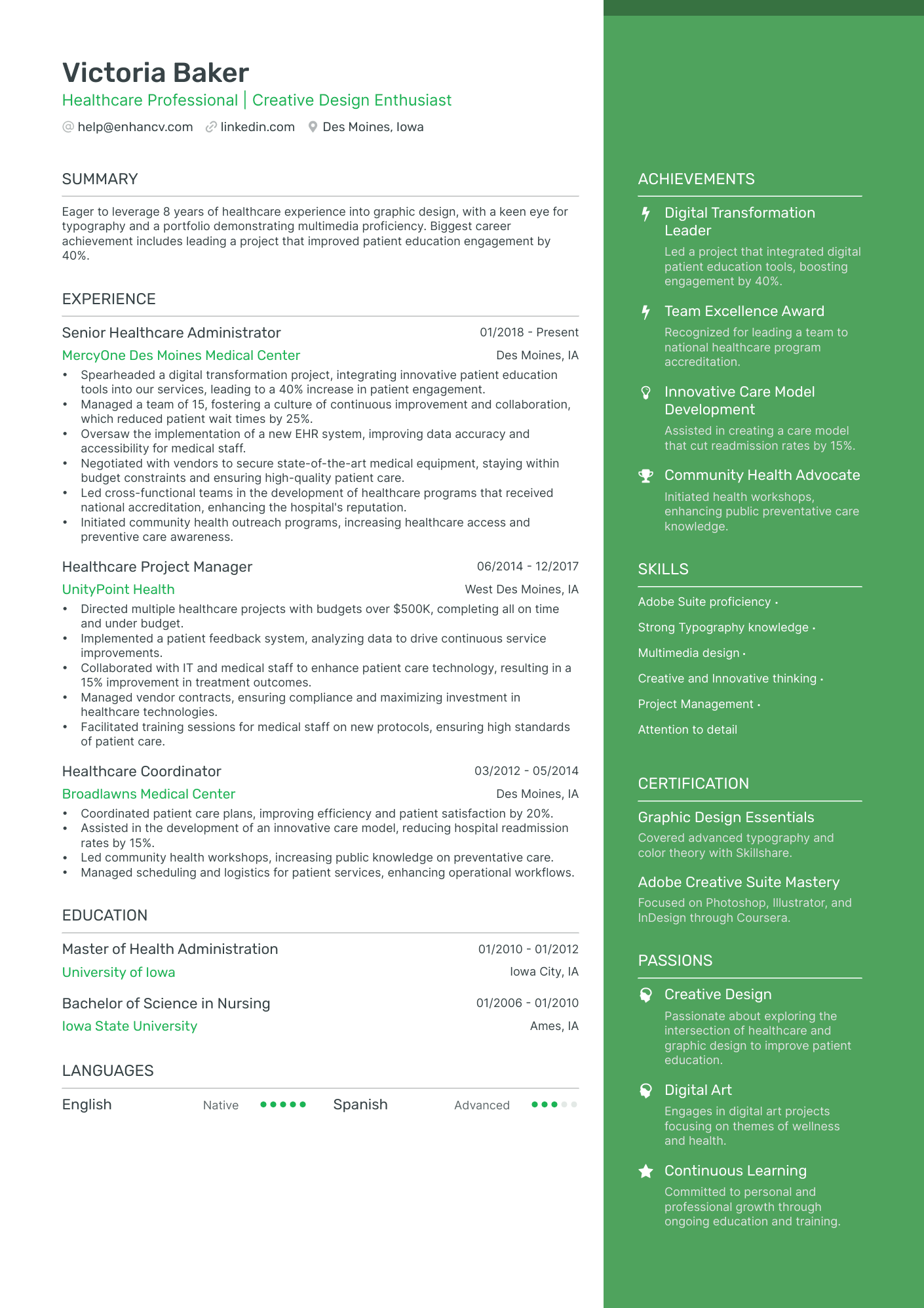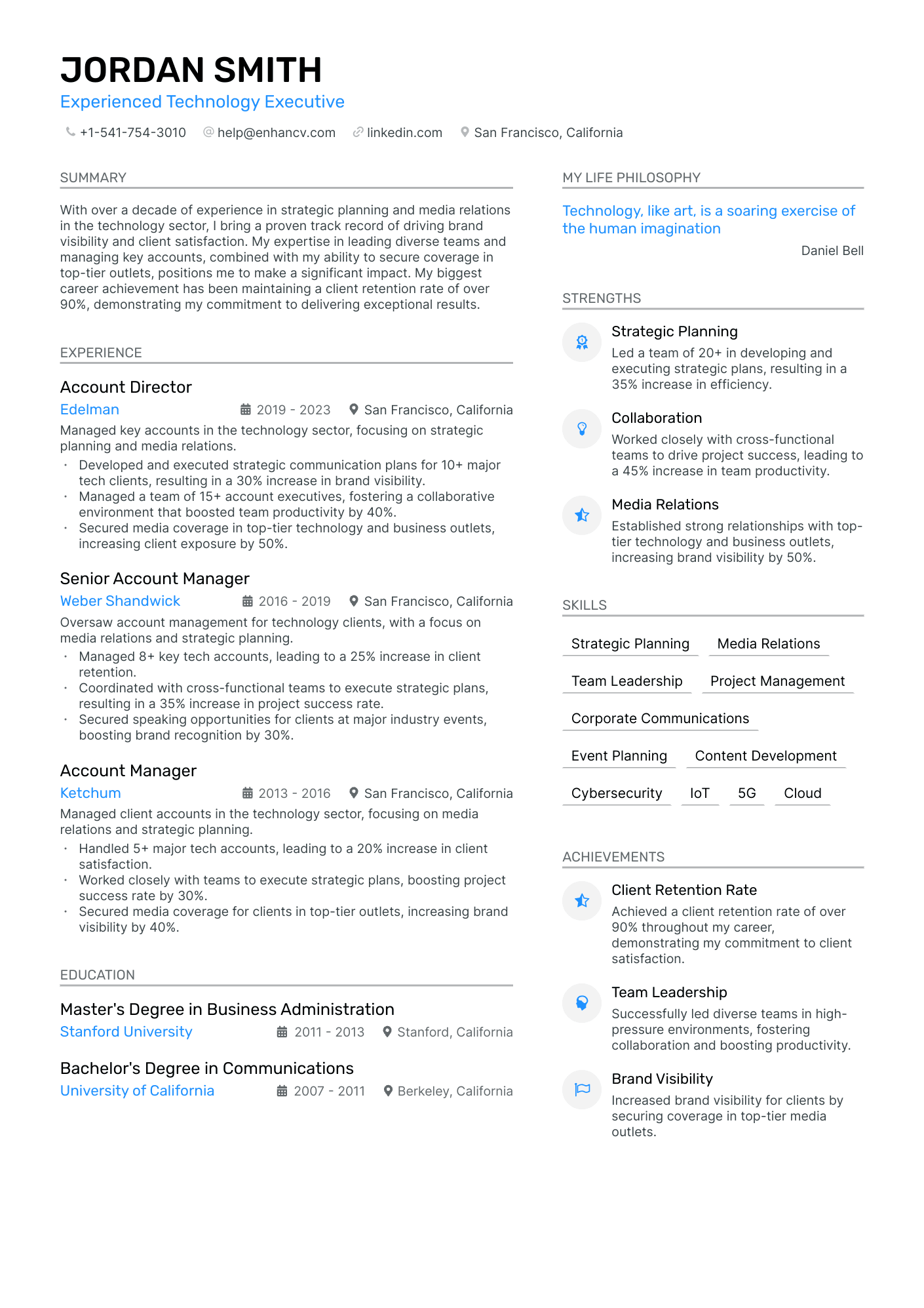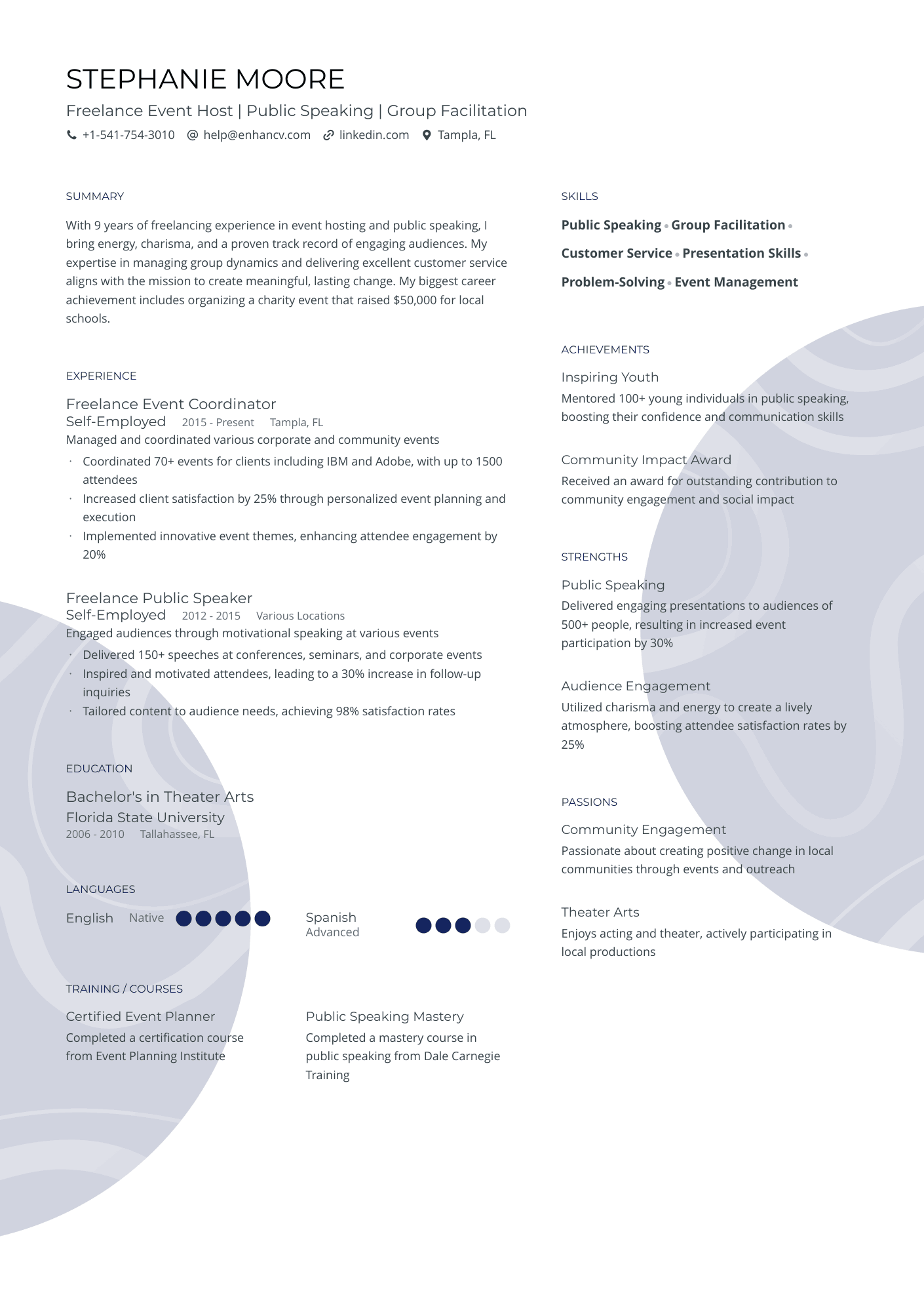When you're putting together a resume, think of it like doing a puzzle. Each piece, or section, has a specific place and purpose. These resume sections include Contact Information, Summary, Work Experience, Education, Skills, and sometimes extras like Certifications or Volunteer Work. Each section tells a part of your story, and how you arrange them defines the overall picture—or format—of your resume.
The order of these sections isn’t just for show—it’s a strategy to highlight your strengths. That’s why it’s so important to tailor the order to match your experience level, ensuring that your most impressive and relevant details catch a recruiter’s eye first.
In this article, we'll dive into the key resume sections and how to arrange them to best showcase your professional journey. Here’s what else we’ll cover:
- Essential sections to include in your resume.
- Optional resume sections that add value to your application.
- How to order your resume to present yourself in the best possible light.
- Different resume formats according to career level.
- Sections to avoid when writing a US resume.
Essential sections to include in your resume
Creating an effective resume starts with including the 5 must-have sections that every recruiter expects to see. These form the backbone of your resume, ensuring you present a comprehensive and organized overview of your qualifications and experiences.
We’ll explore how to best organize them further in the article. For now, let’s see how each one should be written, along with some real-world examples.
Is your resume good enough?
Drop your resume here or choose a file. PDF & DOCX only. Max 2MB file size.
What sections should be on a resume?
- Contact Information
- Career Summary or Objective
- Work Experience
- Education
- Skills
Contact information
At the top section of your application is the resume header—an attention-grabbing element, often in a different color, that’s the first thing recruiters see. It normally uses a larger font size to stand out and includes the following details:
- Start with your contact information—full name, current job title, and location. This ensures recruiters know who you are, where you're based, and if your experience aligns with the job posting.
- Ensure your email address and other contact details are professional. Provide a link to your LinkedIn profile or professional portfolio as well. This gives HR managers quick access to more information about your professional background and work samples.
- It’s better to leave your photo out to keep the focus on your skills and experiences and avoid any potential biases.
PRO TIP
Make sure your name is consistent across your resume, LinkedIn profile, email address, and the file name of your resume. This helps recruiters find your resume more easily among many applicants.
Take a look at a well-written civil engineer’s resume header:
Moving on to the next in line, the professional profile.
Resume summary or objective
It’s a well-known fact that recruiters take just 7 seconds to form an impression of your professional persona. If you don't grab their attention within that short window, your application might end up in the rejection pile. So, how do you make these seconds count? By crafting a standout summary or objective that keeps HR managers reading.
Here’s what you need to know about the two:
The resume summary is a brief overview of your professional history, typically consisting of 3-4 sentences. It highlights your key achievements and skills, giving recruiters a snapshot of your qualifications. This section is ideal for experienced professionals as it quickly conveys your expertise and accomplishments, making it clear why you’re the best fit for the job.
Look at the English teacher resume summary below:
The resume objective on the other hand is a concise statement of your career goals, usually 1-3 sentences long. It outlines what you aim to achieve in your next role and how your skills align with the job. This section is particularly useful for entry-level candidates or those changing careers, as it focuses on your aspirations and potential contributions to the organization.
Consider the example of a junior English language teacher’s career objective:
Whichever you choose, here are the basic guidelines you should follow:
- Tailor the content to the job you’re applying for. This means including a relevant skill, certification, or keyword that will likely grab the reader's attention.
- Start each sentence with an action verb. This reveals straightforwardness and initiative.
- Avoid using the first-person perspective. It can come across as a bit too arrogant.
Next, it’s time to delve into arguably the most substantial part of your resume, the work history section.
Work experience section
The experience section of your resume is a vital part of showcasing what you’ve learned and developed and how that makes you a good fit for the role. This section should be two things above anything else—well-targeted and results-driven.
A targeted resume is customized for a specific job, highlighting the skills, experiences, and accomplishments most relevant to that position. This approach involves tailoring your resume to match the job description and using keywords that align with the employer's needs. It helps you stand out by clearly showing how your qualifications fit the specific role. By focusing on what's most important to the hiring manager, you increase your chances of landing an interview.
So, a targeted work experience section repeats important keywords from the job posting and weaves them throughout the entries. Not only does this lead to a more streamlined resume, but it also makes ATS processing easier. Some applicant tracking systems can recognize keywords from the job description within your resume. But don’t be fooled, hiring managers are still the ones you should be aiming to impress.
As for being results-driven, this means the experience section should demonstrate how well you performed in previous job positions. It's crucial because hiring managers are looking to see the impact you've made in your past roles and how you can bring similar value to their organization.
What recruiters want to see on your resume experience section
- How you contributed and made an impact.
- The results you achieved in your previous roles.
- Your ability to carry out responsibilities reliably.
- Your progression in skills and responsibilities over time.
Here’s what to keep in mind when building your experience section:
- List your job title and employers: Starting with your most recent job and working backward, include the job title, company name, and dates of employment.
- Add a short job description: Clarify what the company does. This is especially important for small startups or NGOs—it gives recruiters context.
- Add task-oriented and results-driven bullet points: Focus on the specific tasks you handled and the results you achieved. Emphasize significant contributions and successes.
- Highlight your impact: Show the positive results you contributed to. Describe projects you focused on that led to successful outcomes. Numbers provide the much-appreciated evidence for your achievements.
- Avoid general duties: Don’t just list your daily routines; instead, focus on what you accomplished.
- Don’t use jargon: Ensure your resume is understandable by everyone, including non-technical staff. Use relevant keywords to draw attention and align your descriptions with the job requirements.
- Keep it concise: Use clear, concise language and avoid fluff. Start each entry with an action verb and avoid repetition.
Below is a good example of a graphic designer’s resume experience:
- •Designed over 50 marketing materials, including brochures, flyers, and posters, leading to a 30% increase in client engagement.
- •Led a rebranding project for a major client, resulting in a 40% boost in brand recognition.
- •Collaborated with the web development team to create visually appealing website designs, enhancing user experience and increasing traffic by 25%.
- •Developed custom illustrations and graphics for client presentations, contributing to a 15% increase in successful project pitches.
Next, let’s focus on another essential resume section which can be as impactful as your job experience—the resume skills.
Skills section
The skills section on a resume might seem like a small part, but it packs a punch—it showcases your top talents and core competencies at a glance. Recruiters often skim through resumes quickly, and a well-crafted skills section can catch their eye, making them want to dive deeper into your application.
When it comes to the types of skills, there are generally two categories: hard skills and soft skills.
Hard skills are your technical abilities and specific knowledge, like programming languages, graphic design, or data analysis. In most cases, these are listed clearly and concisely in a dedicated section or in the work history component, right after the responsibilities. Like so:
- •Implemented custom Salesforce solutions that increased sales team productivity by 30%.
- •Developed and maintained over 50 Apex classes and triggers, improving system performance by 20%.
- •Led a team of 5 developers to complete a major Salesforce integration project, reducing customer response time by 40%.
- •Tools and Technologies: Apex, Visualforce, SOQL, SOSL, Lightning Components, Salesforce DX, Git, Jenkins.
However, your practical skills can be amplified by adding brief descriptions and quantifiable results. Check out the example from a project manager’s resume:
This way of listing skills on a resume is very common, especially for entry-level candidates and career changers who lack prior experience in the role and need to focus on transferable skills or previous achievements. It also exemplifies one of the three resume formats—the functional format, which we’ll discuss in more detail later.
Soft skills, on the other hand, are your interpersonal and organizational abilities, such as dedication, teamwork, and time management. Weaving your people skills into different sections shows how you’ve applied them in real-world situations, making your resume feel cohesive and giving recruiters a comprehensive picture of your capabilities. This approach not only highlights your skills but also demonstrates your achievements and experience, making your resume stand out even more.
Here’s how you can integrate ‘persuasiveness’ into your work history section without explicitly mentioning the skill:
Negotiated and closed high-value deals worth over $1M by effectively addressing client concerns and presenting tailored solutions.
Lastly, let’s tackle another very common resume element—the education section.
Education section
The education section on a resume is where you display your academic background. This part of your resume showcases your formal education, which can include degrees, certifications, and relevant coursework.
The importance of listing your education depends on its relevance to the target job. You could entirely omit this section if it’s not related to the field you’re applying for. However, for junior candidates or recent graduates, emphasizing relevant coursework and academic achievements can be particularly beneficial, as it helps demonstrate knowledge and skills related to the role.
Here’s what you need to keep in mind when describing your educational background on a resume:
- Degree: Start with the highest degree you’ve obtained (e.g., Bachelor’s, Master’s, Ph.D.) and your major or field of study.
- University or college: Include the name of the institution where you earned your degree.
- Location: Mention the city and state (or country, if international) of the institution.
- Graduation date: Provide the year of your graduation. If you’re still studying, indicate your expected graduation date.
- Honors and awards: If applicable, list any honors, awards, or distinctions you received (e.g., summa cum laude, Dean’s List). If you’re fresh out of school, your GPA might come in handy, but only if it’s above 3.5.
- Relevant coursework: Optionally, include coursework relevant to the job you’re applying for, especially if you’re fresh out of college or changing careers.
Here’s what a recent law school graduate might put on their education section:
- •Graduated with honors.
- •Completed coursework in Constitutional Law, Civil Procedure, and Intellectual Property.
- •Participated in the Harvard Law Review as an editor.
- •Engaged in pro bono work providing legal assistance to underprivileged communities.
After covering the basics, it’s time to see what other sections you can include to make an impression.
5 optional resume sections
Beyond the standard sections, consider including additional ones to highlight your qualifications and strengths.
Deciding when to add these sections depends on their relevance to the job and how they can enhance your overall candidacy. For instance, sections like Certifications, Volunteer Experience, or Projects can showcase specialized skills, community involvement, or significant accomplishments.
Before you add another section to your resume, consider the following:
- Space: Only add extra sections if you have enough space. A one-page resume is usually enough for US resume standards. You can create a two-page document if you have over 10 years of direct experience or are trying for a C-level position.
- Tailored approach: Choose sections based on the job requirements. For example, if you lack direct experience, you might include a “Hobbies & Interests” section to show how your leisure activities relate to the role.
- Common additional sections: Certifications, foreign languages, and projects are often even mandatory for certain jobs. The key here is to add those that will strengthen your application the most.
Now, let’s go through the additional sections one by one.
Certifications
Certifications show that you've gone the extra mile to gain specialized knowledge or skills, making you a more attractive candidate. To do it right, create a dedicated section titled "Certifications" and list each certification by its official name, the issuing organization, and the date you received it. This clear presentation helps recruiters quickly see your additional qualifications and how they align with the job you're applying for.
Here’s an example of a police officer’s certificates on a resume:
Note that you can also feature your certifications in the summary, education, or experience section, or, if it’s just one, right next to your job title in the header. Regardless of where you place them, ensure they’re displayed prominently, especially if they’re highly relevant to the role you’re targeting.
Hobbies & interests
Listing hobbies and interests on a resume is especially beneficial for jobs where personality and cultural fit are important. Here are some examples:
- Creative fields (e.g., Design, Writing, Marketing): Showcasing your creative hobbies can give insight into your creative process and inspire confidence in your innovative abilities.
- Customer-facing roles (e.g., Sales, Customer Service, Hospitality): Highlighting interests that demonstrate your interpersonal skills or ability to connect with people can be a big plus.
- Team-oriented jobs (e.g., Project Management, Team Leader): Activities that show teamwork, leadership, or collaboration can help you stand out.
- Startups and small companies: These environments often value a well-rounded personality and a good cultural fit, so showing your interests can help you connect with the company culture.
- Non-profits and social work: Volunteering and community involvement can demonstrate your commitment to social causes and empathy.
To do it right, create a "Hobbies and Interests" section and list a few activities that you’re passionate about. Keep it relevant and professional—think volunteering, photography, or playing a musical instrument.
Look at an example of how a social media manager listed their passions on their resume:
Volunteer experience
Including volunteer experience on your resume can set you apart from other candidates. It showcases your dedication, skills, and willingness to contribute to the community, reflecting positively on your character.
To do it right, treat your volunteer roles like any job: list the organization, your role, and key accomplishments or skills you gained. This can be particularly impressive in professions like education, healthcare, social services, and non-profits, where a passion for helping others is a big plus. Even in fields like marketing or tech, volunteer work can highlight valuable soft skills and a proactive attitude.
Look at an example from a firefighter’s resume:
- •Led a team of 10 volunteer firefighters in responding to wildfires and wildland fires, implementing fire suppression strategies.
- •Participated in 3 prescribed burn operations, reducing the risk of uncontrolled wildfires and enhancing ecosystem health.
Awards and recognitions
Listing awards and recognitions on your resume is a fantastic way to highlight your achievements and differentiate yourself from others. These accolades show that your hard work and skills have been acknowledged by others, boosting your credibility.
To include them, create a dedicated section titled "Awards and Recognitions," then list each award with the name, the granting organization, and the date received. This is suitable for any profession, from academia and business to creative fields and tech, as it demonstrates excellence and recognition in your area. Below is an example taken from a PR specialist’s resume:
Projects and extracurricular activities
Projects are a great way to showcase your hands-on experience and specific skills in action. They’re especially useful in fields like IT, engineering, marketing, and design, where demonstrating your practical abilities can make a big impact.
Here’s how to do it:
- Create a "Projects" section and place it prominently in a colored panel or near the top.
- For each project, list the title, a brief description, your role, and key achievements or skills used.
- Be sure to highlight any measurable outcomes, like improved efficiency or increased sales.
By detailing your projects, you’re giving employers a clear picture of what you can bring to the table. Take a look at the example below from a Chief Technology Officer’s resume:
- •Successfully decreased equipment downtime by 50% and maintenance costs by 20% for our pilot manufacturing plant.
- •The platform has been adopted by five major manufacturing companies, significantly boosting our SaaS offerings.
Now that we’ve covered all the must-have and optional sections, let’s look at how you can shuffle them around to communicate different work circumstances.
Why the order of your resume sections matters
The order of sections on a resume matters because it helps highlight your most relevant skills and experiences to potential employers. It makes it easier for them to quickly assess your suitability for the job.
Keep in mind the following factors when deciding on the organization of your resume.
- First impressions count: Recruiters often skim resumes, so placing the most important information first ensures it gets noticed.
- Relevance to job: Tailor the order to match the job description. This shows you understand the role and are a good fit.
- Highlighting strengths: Putting your strongest qualifications and achievements at the top can capture the employer's interest right away. This is particularly important for less-experienced candidates.
- Logical flow: A clear, logical structure makes your resume easier to read and understand, improving its overall effectiveness.
- Guiding the reader: If you order the sections strategically, you can guide the reader's attention to the areas you want to emphasize.
- Professionalism: A well-organized resume reflects your attention to detail and professionalism, which are attractive qualities in any candidate.
PRO TIP
UX design studies confirm that people primarily scan rather than read content word-for-word. To optimize your resume, place critical information like contact details and a professional summary at the top. Use clear headings, bulleted lists, and bold text to highlight key points, making it easy for readers to quickly find and absorb important details. Align your layout with natural scanning patterns to ensure your most impressive achievements stand out.
How to organize different sections on a resume + 5 examples
When we talk about the different ways to organize a resume, we mean the resume format. There’s one rule that’s not going to change anytime soon: The most important details go first on your resume.
This rule defines which sections are prioritized and go at the top of the page, whether to use a double-column or single-column resume structure, if and how to use color for emphasis, and how to ensure there’s enough white space between elements. For example, if you’re writing your first resume, you’ll likely want to use a traditional template to make a smaller amount of content fit evenly on the page.
Did you know that the way people read web pages and documents can help you design a more effective resume? Eye-tracking studies show that readers often follow an "F" or "T" pattern. This means they scan across the top and down the left side, making the top section and left column prime spots for your most important information, like your name, contact details, and key skills.
So, next time you're tweaking your resume, remember to place your critical details where they'll catch the eye first!
Now, let’s look at the three main resume formats: reverse chronological, functional, and combination.
- Reverse chronological resume: Lists work experience in reverse chronological order (starting from the most recent and working backward). It’s best for those with a strong work history in the same field, as it highlights consistent employment and career progression.
- Functional resume: Focuses on skills and experience rather than work history. This format is ideal for career changers or those with gaps in their employment, as it emphasizes what you can do rather than when you did it.
- Combination resume: Merges elements of both chronological and functional formats. Also known as hybrid, the combination format is suitable for individuals with diverse skills and a solid work history, as it allows them to showcase relevant skills and experience together.
However, if you’re still uncertain about how to approach your resume building, we’ve provided some ready-made solutions below. Whichever one you choose, with the help of Enhancv’s resume builder, you can rearrange the sections to suit your needs later.
Resume section order based on your career situation
Your resume section order and format will depend on your career situation. Let’s explore some specific examples and how they can benefit different types of job seekers:
Recent graduates
Candidates who are looking for their first job or internship need to emphasize education and relevant coursework to underline academic achievements and skills.
Follow this approach when building a resume:
- Focus on education: Start with the education section, detailing your degree, major, and any honors or awards. You can also include courses that are directly related to the job or internship you’re applying for to show your knowledge and interest in the field.
- Illustrate skills: List any skills that are pertinent to the job, including technical skills, languages, or software proficiency.
- Include extracurricular activities: Mention any clubs, organizations, or volunteer work that demonstrate leadership, teamwork, and other valuable qualities.
- Add internships or part-time jobs: If you have any work experience, even if it's not directly related to your field, include it to show your work ethic and transferable skills.
- Use a simple format: Opt for a clean, single-column template that makes the content easy to read and ensures all your information is clearly presented.
Career changers
Career changers should focus on transferable skills and relevant experiences to demonstrate their suitability for a new field.
Here are a few tips for building your resume when coming from a different industry:
- Highlight transferable skills: Start by listing skills that are pertinent to the new career. These can include technical skills, soft skills, languages, or software proficiency that apply across industries.
- Focus on relevant experience: Include any work experience that showcases your transferable skills, even if it's from a different industry. Show specific achievements that demonstrate your ability to succeed in a new field.
- Display education and training: If you have completed any courses, certifications, or degrees related to your new career, make sure to feature them prominently. This demonstrates your commitment to transitioning and acquiring new knowledge.
- Include volunteer work or freelance projects: Any unpaid or freelance work that’s relevant to your new career can provide valuable experience and show your dedication to the field.
- Tailor your professional summary: Write a summary that clearly states your career change goals and highlights your relevant skills and experiences. Make sure to convey your enthusiasm for the new field.
Experienced professionals
Seasoned candidates can maximize their impact by using a reverse chronological resume. This format illustrates their extensive work history and accomplishments and is favored by recruiters for its natural reading flow and high ATS compatibility.
Here are our tips for making a standout resume for an accomplished candidate:
- Showcase professional experience: Place your work experience section right after the resume summary. Highlight key responsibilities, achievements, and contributions in each role, using quantifiable metrics when possible.
- Feature leadership and management skills: Emphasize your experience in leadership and management roles. Show your ability to lead teams, manage projects, and drive organizational success.
- Include professional development: Mention any additional training, certifications, or courses that have furthered your expertise in your field. This demonstrates your commitment to continuous learning and staying current.
- List relevant skills: Include a skills section that outlines your technical and soft skills pertinent to the job you are applying for. This helps employers quickly identify your key competencies.
- Use a professional format: Choose a clean, polished template that reflects your professionalism. Ensure that all information is presented clearly and is easy to read.
Job seekers with employment gaps
You can still create a strong resume by focusing on your skills and relevant experiences. A functional or combination resume format can help de-emphasize your time away from the workforce and underline your qualifications instead.
Here are a few more suggestions:
- Include a professional summary: Write a summary that focuses on your skills and experiences, briefly explaining any gaps if necessary. Emphasize your readiness to re-enter the workforce and contribute to a new role.
- Highlight relevant experience: Include any work experience, freelance projects, volunteer work, or internships that are relevant to the job you’re applying for. Display your key responsibilities and achievements in these roles.
- Explain career gaps positively: If you choose to address employment gaps directly, do so in a positive light. Briefly explain the reason for the gap and focus on any productive activities you undertook during that time, such as further education, volunteer work, or skill development.
- Use a functional or hybrid format: Opt for a resume format that takes the focus away from your chronological work history and puts more emphasis on skills and achievements. This helps to draw attention towards your qualifications.
Freelancers or consultants
If you’re a freelancer or working in consultancy, you should create a resume that underscores your diverse skills, project experience, and ability to deliver results. A combination resume format is often ideal, as it shows both skills and work history.
Here are a few more tips:
- Write a compelling summary: Create a summary that underlines your versatility, expertise, and key achievements. Mention the breadth of your experience across different industries or sectors.
- Highlight key projects and clients: Start with a section that lists major projects and notable clients. Briefly describe each project, your role, and the outcomes or achievements. This emphasizes your ability to deliver results in various settings.
- Include relevant skills: Your skills section should outline technical and soft skills pertinent to your freelance work. Demonstrate skills such as project management, client communication, and any industry-specific competencies.
- Detail your work experience: In the work experience section, list your freelance or consulting roles in reverse chronological order. Include a few bullet points for each role, focusing on your contributions and successes.
- Showcase flexibility and adaptability: Underline your ability to adapt to different projects, industries, and client needs. Highlight any experiences that demonstrate your versatility and problem-solving skills.
How to format resume sections for applicant tracking systems
Navigating the world of ATS can be a bit tricky, but with a few tips, you can format your resume to pass through them smoothly.
Here are some friendly pointers:
- Use standard section headings: ATSs are trained to recognize headings like "Work Experience," "Education," and "Skills", so don’t get too creative with them.
- Choose standard fonts: Easy-to-read fonts like Arial, Rubik, Lato, or Bitter. Less traditional fonts might look cool, but they can confuse the ATS.
- Avoid fancy formatting. Graphics, tables, and unusual symbols might confuse ATS. Also, keep your contact info and other key details within the main body of the resume.
- Mirror the job description: Incorporate keywords from the job description naturally into your resume. This helps the ATS recognize that you’re a good match.
- Use both acronyms and full terms: If a job description mentions "SEO (Search Engine Optimization)," use both the acronym and the full term in your resume.
- Stick to bullet points: Bullet points are great for readability and help ATS break down your information into digestible pieces.
- Use a standard file type: Submit your resume as a .pdf file. These formats are typically ATS-friendly. However, if the job posting specifies a preferred format, always follow that guideline.
For more information on the topic, read our extensive ATS Resume Examples & Guide.
Enhancv’s unique sections
We believe that a resume should reflect not just your professional qualifications but also who you are as a person. To help recruiters get a well-rounded view of their candidates, we’ve introduced some unique sections to include in your resume. Here’s a brief overview of these components and when to use them:
- My time: This section is your opportunity to share how you spend your free time. Whether it's hobbies, volunteer work, or side projects, this gives recruiters an insight into your passions and how you balance work and personal life. Use this section to highlight activities that demonstrate skills or qualities relevant to the job.
- My life philosophy: Here, you can articulate your core beliefs and values. This section helps employers understand what drives you and how your personal philosophy aligns with their company culture.
- Books: Share the books that have had a significant impact on you. They’ll offer a glimpse into your interests, continuous learning habits, and the sources of your inspiration.
- Find me online: In this digital age, your online presence can say a lot. Provide links to your professional social media profiles, personal website, blog, or portfolio here. It’s particularly useful if you have an active online presence that showcases your expertise and interests.
- Custom: This is a flexible section where you can include any additional information that doesn’t fit into the traditional categories. It could be a unique project, a personal story, or any other detail that you believe is important. Plus, you can change its title anytime.
Enhancv offers a variety of customizable templates that can be tailored to any job with just a couple of clicks. Our user-friendly interface allows you to easily adjust sections, layouts, and designs to create a resume that perfectly fits your needs and demonstrates your unique strengths.
These sections are designed to help hiring managers get to know the person behind the resume. Feel free to use the ones that best showcase who you are and what you can contribute.
Resume sections to avoid
When crafting your resume, there are a few sections you might want to avoid to ensure it remains professional and relevant. Here are some key sections to skip and the reasons why:
- References: Including references directly on your resume can take up valuable space. Employers typically request references later in the hiring process, so it's best to save this information for when it's specifically asked for.
- Photo: Adding a photo is generally unnecessary and can lead to unintentional bias. Exceptions include industries like modeling or acting, where appearance is a part of the job. For most other professions, a photo can detract from the content of your resume.
- GPA: Unless you are a recent graduate with an exceptionally high GPA, it's often best to leave this off your resume. Many employers prioritize experience and skills over academic performance, especially for more experienced candidates.
- Soft skills: While soft skills are very important, simply listing them without context can seem vague. Instead, demonstrate these skills through your achievements and experiences. For example, rather than stating "excellent communication skills," provide an example of a successful project that required effective communication.
Key takeaways
Now that you’ve covered everything you need to know about resume sections, you're ready to build a perfectly personalized resume that attracts recruiters.
Here's a quick rundown of what you need to keep in mind:
- Essential sections: Include the basics like Contact Information, Career Summary or Objective, Work Experience, Education, and Skills to provide a comprehensive overview of your qualifications.
- Optional sections: Add Certifications, Volunteer Experience, Projects, and Extracurricular Activities if they enhance your application and align with the job requirements.
- Order matters: Arrange your sections to highlight your most impressive and relevant details first, tailored to match your experience level and the job description.
- Resume formats: Choose between reverse chronological, functional, and combination formats based on your career situation.
- ATS compatibility: Use standard section headings, simple fonts, and avoid fancy formatting to ensure your resume is easily parsed by ATS.
- Unique Enhancv sections: Enhance your resume with unique sections like My Time, My Life Philosophy, Books, Find Me Online, and Custom to give recruiters a well-rounded view of who you are.
- Sections to avoid: Skip including references, photos (unless required for specific industries), GPA (unless exceptionally high and relevant), and soft skills without context.
Make one that's truly you.

